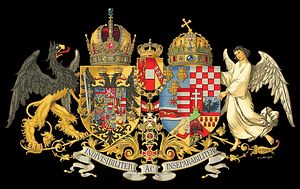During this week’s podcast I briefly mentioned an idea that I would like to explore a bit further: The striking similarities between the strategic position of India in the 21st century with that of the now vanished empire of Austria-Hungary in the 19th and early 20th century. I’ve published similar pieces looking at this analogy previously at The Huffington Post and China-US Focus, but I thought I would repost some of my observations here as well.
To this day, India’s foreign policy, much like Austria-Hungary’s is – more than most other emerging titans – constrained by a quest for internal security and a deep introspection – making it a reluctant power and conducting a more or less ‘introverted foreign policy’.
The Austrian Empire, like India, was considered to be a bridging power between East and West for much of its existence. It was a multi-national empire, more concerned with its internal security and stability than with great power politics, and after humiliating defeats in 1859 and 1866, reluctant to use military power to achieve its political objectives (for most of the late 19th century-early 20th period it spent comparatively little on military defense). As with the Sino-Indian war of 1962, these defeats lead to various military and political reforms culminating in the Austro-Hungarian compromise of 1867 and the establishment of a dual monarchy. Also, like India, Austria-Hungary was held together by an omnipotent, if slightly inefficient, bureaucracy.
Austria’s “Pakistan” in the 20th century was Serbia, a small state in the Balkans trying to lure the South Slavic subjects of the empire to revolt through subversive means (as with Pakistan there was a clandestine connection between government circles and radical elements in the Serbian intelligence community). Most importantly, Austria’s stance vis-à-vis Serbia was emboldened by its dual alliance with the German Empire, which in 1914 , after the assassination, gave Austria a diplomatic carte blanche, to deal once and for all with the “Serbian problem”.
Before this dual alliance, Austria always had to play a rather careful diplomatic game between East and West. The great protector power of Serbia was Russia, Austria’s powerful eastern neighbor (cf. the Russian, Count Vronsky, who in the novel, Ana Karenina, departs for Serbia at the end of the novel to participate in the Orthodox Serbian revolt against the Turks) threatening Austria’s exposed eastern borders. As the years progressed and tensions between the great powers mounted and the dual alliance solidified, Austria took an increasingly more aggressive stance against Serbia’s agitations.
In 1914, after the assassination of Archduke Ferdinand of Austria, Austria’s Chief of Staff Conrad von Hoetzendorf’s repeated request for preventive war with Serbia was finally granted. Not before Austria, however, thought it had secured Germany’s guarantee to help defend its eastern borders, plunging all of Europe into the First World War.
India today faces many similar problems as Austria did in the early 20th century. A powerful peer competitor in the East conducting a relatively subtle anti-Indian South Asian policy and a smaller, but more real subversive threat coming from Pakistan (notwithstanding the nuclear component of this equation) and continuing internal unrest. Add the world’s strongest military power, the United States, to this mix and the results could be explosive. According to various foreign policy experts in New Delhi, India is very aware of the delicate situation it occupies.
The United States would do well not to foster too close of a relationship with India in the next few years of its ‘rebalance’ to Asia and should maintain the status quo. India has cautiously positioned herself between both parties in US-China competition. China has made it clear in numerous statements that it is not a threat to India, whereas India’s defense ministry clearly stated that India is not interested in containing China.
India’s diplomacy of peace and non-alignment is deeply felt and comes more naturally to it than war. In the near term the much bigger danger of an emboldened India may well be an increase in crypto-nationalism and inter-communal extremism.
The United States should heed the maxim “be careful what you wish for.” For closer military and diplomatic ties between India and the United States may embolden India’s foreign policy, which could potentially destabilize the entire region of South Asia. As history teaches us, multicultural great powers often have a need to define their national identities by overarching national ‘exertions’ such as a war. In conclusion, the Obama Administration should carefully evaluate its relationship with India in 2015 and beware of the unintentional but often hazardous consequences of Great Power politics. What do you think dear reader?
Note: Similar versions of this piece have been published over at The Huffington Post and at China-US Focus, as was mentioned earlier.

































